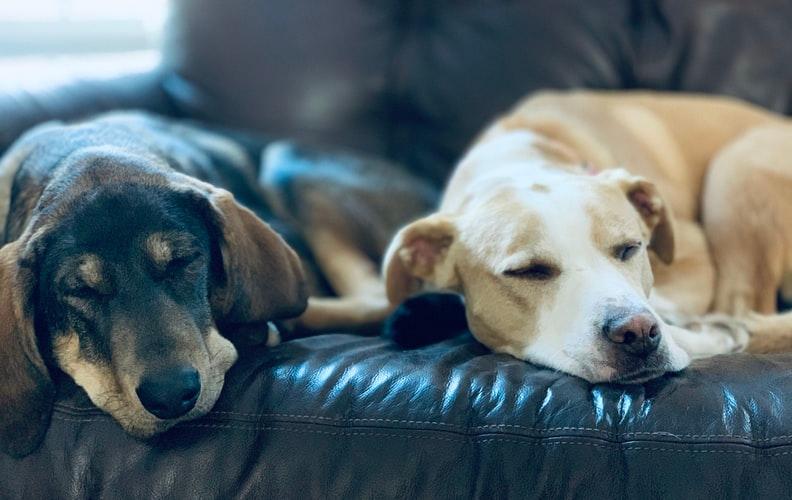In this blog, we explore and explain what your dog’s sleeping position means. We’ll discuss the different positions dogs like to sleep in, the meaning behind each resting position, and the dog’s sleeping habits. Read on to discover some of the reasons behind your dog’s sleeping position and more!
Dog Sleeping Positions And What They Mean

If you’re a pet parent, you may well have noticed that dogs sleep a lot more than people do! Bigger breeds of dogs tend to need longer naps than smaller ones, and if you have a puppy, they can snooze for up to 19 hours a day whilst they develop and grow!
Did you know that your dog’s sleeping position can reveal a lot about their health and happiness? But, you can only interpret this if you know what to look for. Their sleeping position may change depending on which area of the house they’re in, who or what they’re sleeping near, or simply their mood.
Our four-legged friends have such curious personalities, so it’s only sensical that they come out when they’re snoozing too. Why do our dogs sleep in such weird positions?

Sleeping On Their Side
This is the most common posture that doggies adopt when they sleep: on their side, legs extended. This is a comfortable, relaxed, and happy doggo! They’re clearly very trusting of their surroundings.
This dog sleep position also indicates a deeper stage of sleep, and you may even catch your pooch dreaming in this dog sleeping position. If your dog likes to sleep on their side, make sure they have ample room to do so and that their dog bed isn’t too small.
Sleeping On Their Belly
If your dog is asleep on their front, chin resting on their paws, this usually means that your pet is having a rest rather than a full-blown snooze. They’ll either change positions to move into a deeper state of sleep, or they’ll get up again when they’re ready.
The Superhero
This is when your dog’s chin is on the floor, and their arms and legs are spread out, kind of like a superhero! This is a position more commonly adopted by puppies or high-energy breeds, who need to nap more frequently but also want to be ready to jump back into play as soon as they’re ready!
Curled Up in a Ball
When your dog curls up nose to tail, this makes them as small as possible, which helps them keep warm. It is also a protective pose as their rear and head are covering their most vital organs.
This sleeping position doesn’t allow for much movement and can mean various things: they’re not as comfortable in their surroundings, they’re keeping warm (so, you may see this position more often during the colder months of the year), or they just prefer it!
If you notice that your dog is showing signs of occasional stress during the day and sleeping in a protective position, our calming chews for dogs can help promote relaxation before they go to sleep.
Sleeping On Their Back
The very opposite to being curled up, an exposed belly means your dog needs to cool off, so you’ll likely see this position in warmer months or if the heater’s been on.
The fur is thinner on the dog’s stomach or belly, and your dog’s paws are where their sweat glands are located, so when they expose these areas, they can cool down more easily. But, this also means they are extremely trusting of where they’ve chosen to rest: they’re exposing the most vulnerable areas of their body in this position.
Sleeping With You or Other Pets
So, your dog likes to snuggle – aww! As well as a sign of affection and trust, this position also provides them with a sense of comfort, security, and warmth. Puppies do this with their mothers as they have more difficulty regulating their body heat when they’re very small. This behavior tends to stick as they mature because they like it, and it’s a way of bonding.

FAQs About Sleeping Dogs
Now that you understand why your dog might sleep in these positions, let’s answer some questions regarding dogs and their sleeping behaviors:
How long do dogs sleep?
Adult dogs generally sleep between 12-14 hours a day, with puppies and older dogs requiring more sleep. If you notice that your dog is extra tired and sleeping more than normal, contact your vet to make sure nothing is wrong.
Why does my dog circle/dig their bed before they sleep?
This behavior is very ancestral – wolves would flatten the grass and leaves to make the area more comfortable. Wolves are thought to have also dug holes in colder months to sleep in for warmth and protection.
If your dog’s circling seems excessive to you, this could be a cause for concern, and it’s worth getting them checked over by a vet.
Why does my dog twitch when they sleep?
Movement in your dog’s sleep is usually a sign of them dreaming – they’re in a deep sleep state when this happens, and it’s best to not disturb them. Tail wagging, twitching, the odd kick of a leg, and a grunt are all common behaviors while dreaming.
However, a twitch can be a sign of being too cold. So if you’re cold or your house feels a bit chilly, it might be worth giving them a blanket if you see this.
PetLab Co. Advice: If the twitching is excessive or seems abnormal, this could indicate a fit or a seizure. Try to wake them by calling their name, and if they are unresponsive and continue to shake, stiffen up, or excessively twitch, call an emergency vet.
Can dogs have nightmares?
When their sleep movement is more aggressive, they seem agitated or they are barking whilst they’re asleep, this can indicate a nightmare. That’s right – dogs can have bad dreams, just like us! If they don’t wake up themselves and seem distressed, offer them a soothing pet and softly call their name to let them know you’re there. They will either wake up, or stay asleep and calm down.
A Final Word on Dog Sleeping Positions
So, now you know what your dog’s unique sleeping positions mean! When dogs spend such a large amount of their time sleeping, it’s good to know as a pet parent the different positions they adopt so you can interpret their mood, temperature, health, and comfortability.
Sources
“Dogs’ Sleeping Positions and Habits Tell You a Lot about Their Personality and Health.” DogTime, 25 May 2021, https://dogtime.com/dog-health/dog-behavior/48213-dogs-sleeping-positions-habits-tell-lot-personality-health
Editorial, PetMD. “5 Dog Sleeping Positions and What They Mean.” PetMD, PetMD, 4 Oct. 2021, https://www.petmd.com/dog/wellness/5-dog-sleeping-positions-and-what-they-mean
 S
S



